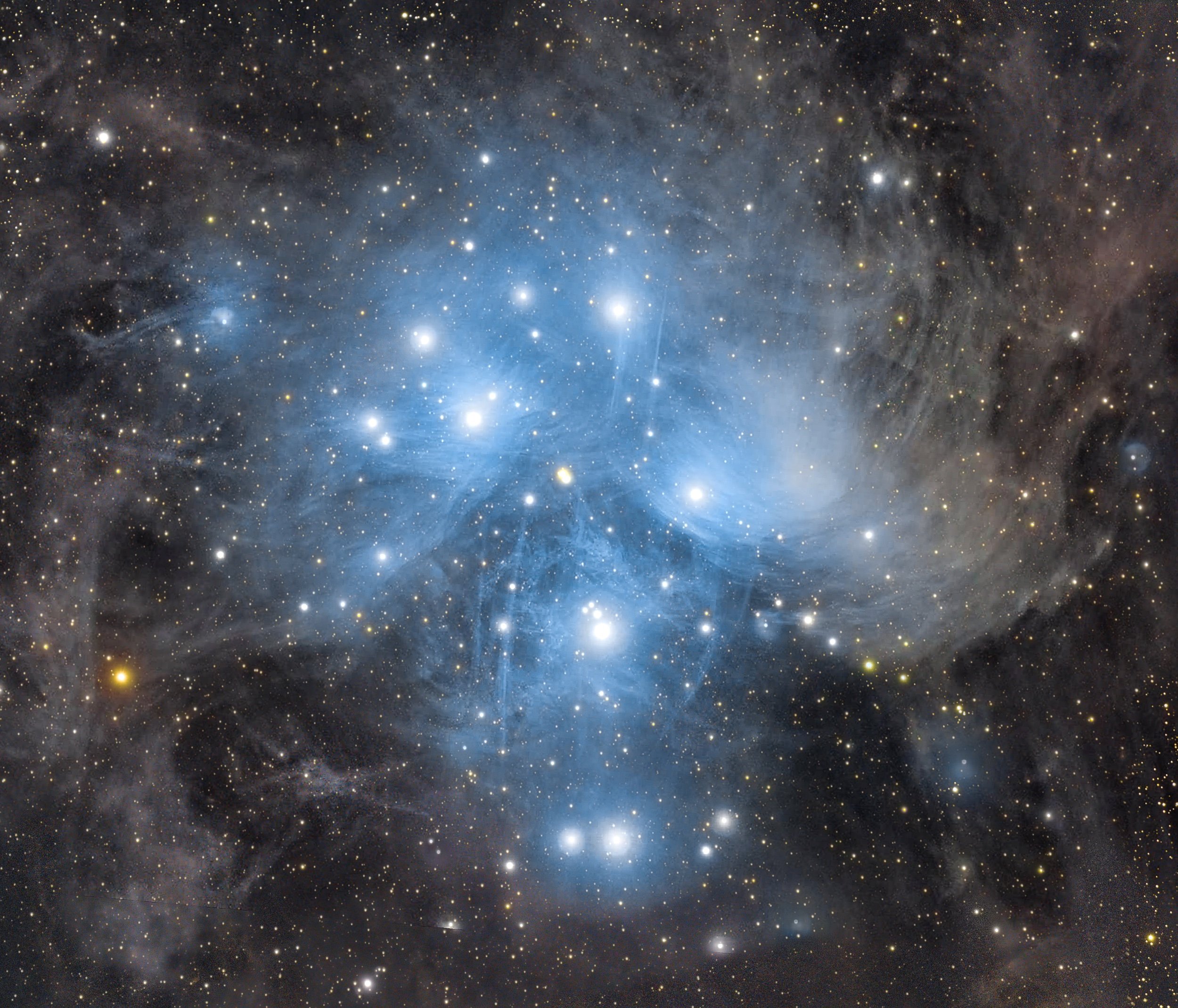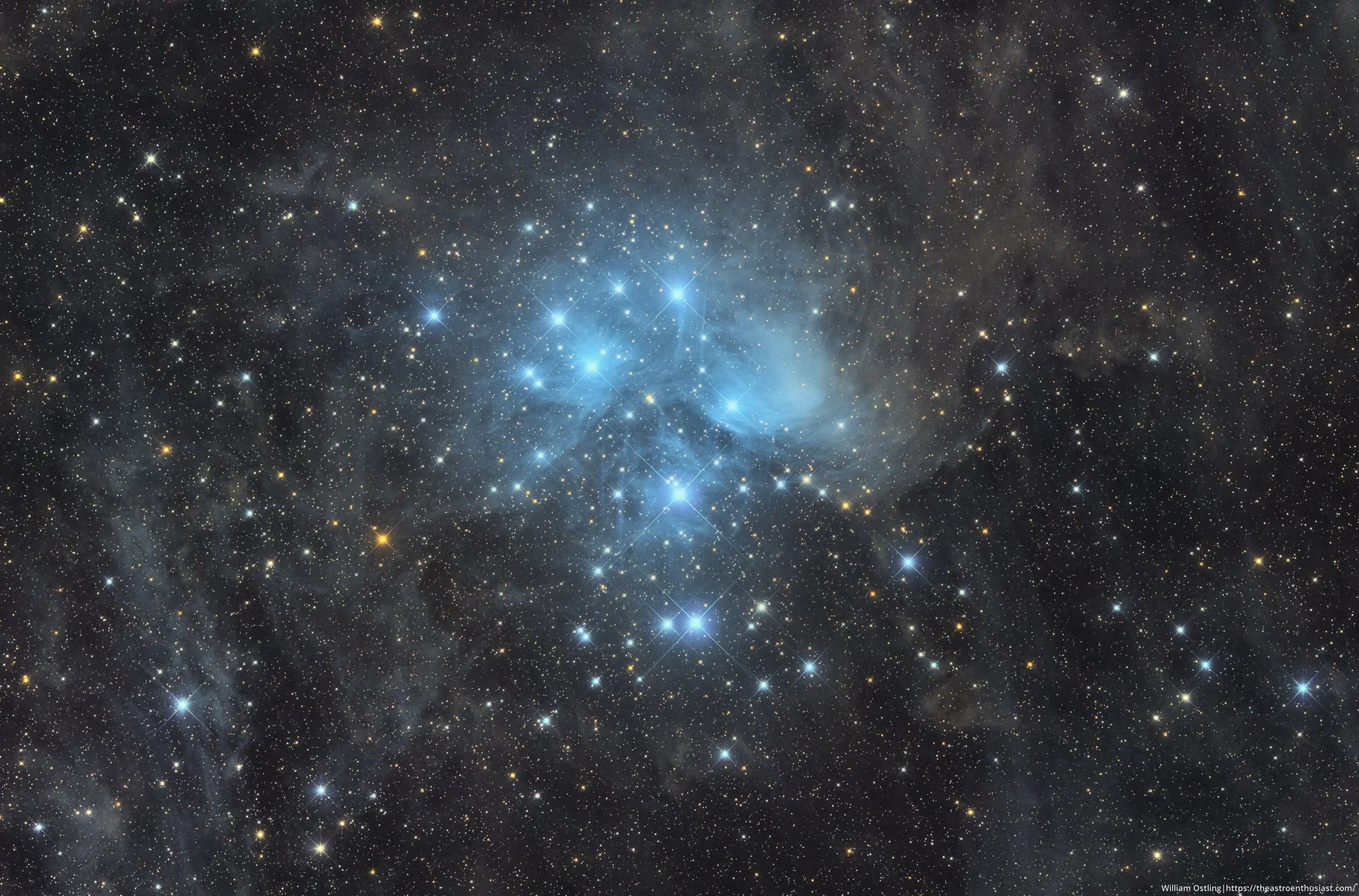
AAPOD2 Image Archives
M45 Les pléiades
The Pleiades, also known as M45, is one of the most recognizable open star clusters in the night sky. Located about 440 light-years away in the constellation Taurus, this young cluster is dominated by hot, blue B-type stars that illuminate the surrounding wisps of interstellar dust. These reflection nebulae create the characteristic blue glow, a result of fine dust scattering the starlight. While the cluster itself is estimated to be around 100 million years old, the nebulosity is not a remnant of its formation but rather a passing interstellar cloud through which the stars are currently moving.
Captured from Biars-sur-Cère, Occitanie, France, under moderate sky conditions, this image reveals the intricate interplay of light and dust surrounding the Pleiades. High dynamic range processing preserves the delicate filamentary structures of the reflection nebula while maintaining the contrast between the bright stars and the dark interstellar medium. The deep exposure also highlights faint surrounding gas, offering a glimpse into the complex environment of this stellar nursery.
The Seven Sisters
Rising high on Christmas Day, the Pleiades star cluster (M45), known as the Seven Sisters, graces the heavens with a festive glow. In this image, the cluster is framed vertically, resembling a sparkling celestial Christmas tree. The bright blue stars, adorned with wisps of reflection nebulae, form a striking "ornamented" structure against the dark backdrop of space, as if dusted with cosmic snow.
This seasonal alignment invites us to look skyward and reflect on the beauty and wonder of the universe. Much like the spirit of the holidays, the Pleiades reminds us of connection and light, shining brightly as a timeless symbol of hope and renewal.
The Seven Sisters
M45, commonly known as the Pleiades or the Seven Sisters, presents a captivating celestial panorama with distinctive blue hues in astrophotographs. The dominant reason behind this intense blue appearance lies in the interstellar dust surrounding the stars within the cluster. As starlight passes through this cosmic dust, it undergoes a process known as Rayleigh scattering.
Rayleigh scattering, more commonly associated with why the Earth's sky appears blue during the day, occurs when short wavelengths of light (such as blue) scatter more effectively than longer wavelengths (such as red). In the case of the Pleiades, the blue light from the stars is scattered by the intervening interstellar dust, resulting in the cluster's pronounced blue coloration when captured through astrophotography.
This scattering phenomenon not only contributes to the distinct visual beauty of the Pleiades but also serves as a valuable astrophysical tool for astronomers. By studying the extent of this scattering, scientists can gain insights into the distribution and properties of the intervening interstellar material, providing a deeper understanding of the cosmic environment surrounding this iconic star cluster.
M45 (Pleiades) in HOORGB
Image Description and Details : M45 (Pleiades) in HOORGB, 98 hours taken over the course of 19 nights.I've wanted to take this picture for a couple of years, but whenever I could get to my dark sky site, it was cloudy. The stars finally aligned (literally) and I was able to get a good amount of RGB data from my dark sky site this winter.During my research for taking this photo, I noticed that some images had small amount of faint Hydrogen Alpha immediately around M45, so I figured I'd pile on some HA data for my wide field image and see if any more hydrogen would present itself...I was pleasantly surprised to find some wispy streams of hydrogen that I'd never seen before, right outside of the star cluster.The RGB data was taken from my dark sky site in Bone Cave, TN. The narrowband data was taken from my backyard in Nashville, TN.Imaging details:Imaging Telescope: TPO UltraWide 180 f/4.5 Imaging Camera: ZWO ASI2600MC Pro Mount: Sky-Watcher EQ6-R Pro Filters:Baader Fringe Killer 2"Optolong L-eXtreme 2" Accessories: ZWO ASIAIR Plus, ZWO EAFSoftware: Adobe Photoshop, Aries Productions Astro Pixel Processor (APP), Pleiades Astrophoto PixInsightGuiding Telescope: ZWO 30mm Mini Guider ScopeGuiding Camera: ZWO ASI290MM Mini Dates:Nov. 18, 2022, Nov. 19, 2022, Nov. 20, 2022, Nov. 21, 2022, Nov. 22, 2022, Nov. 23, 2022, Nov. 28, 2022, Nov. 30, 2022, Dec. 12, 2022, Dec. 15, 2022, Dec. 16, 2022, Dec. 17, 2022, Dec. 18, 2022, Dec. 19, 2022, Dec. 20, 2022, Dec. 23, 2022, Dec. 24, 2022, Dec. 25, 2022, Dec. 27, 2022, Jan. 1, 2023Frames:Baader Fringe Killer 2": 538×240″ (35h 52′) (gain: 100.00) -10°COptolong L-eXtreme 2": 467×480″ (62h 16′) (gain: 100.00) -10°CTotal Integration: 98h 8′Darks: 60Flats: 60Flat darks: 100
Copyright: Copyright: Jeffrey Horne
Grand Pleiades
Image Description and Details : Perhaps the most famous star cluster on the sky, the bright stars of the Pleiades can be seen without binoculars from even the depths of a light-polluted city. With a long exposure from a dark location, though, the dust cloud surrounding the Pleiades star cluster becomes very evident.
Two techniques were used to get this image: framing selection and downsampling. I chose only about 65% of the frames that I actually shot, removing bad signal from out of focus, cloudy, or polluted frames. I also downsampled the image by 50% increasing snr and the amount of dust I imaged.
Equipment:
Nikon D90
Sigma 300mm prime lens
Sky-Watcher Star Adventurer
Star Adventurer Tripod
Bahintov Mask
Intervalometer
DIY diffraction spikes
Stellarium
All Sky Plate Solver
Nina
Acquisition:
ISO 800, f/4.0
Taken from a bortle 2 zone during the new moon.
Taken on 10/4, 10/6, 10/7, 10/8
231 x 3′ light frames (11.2 hours)
200 total flat frames
67 dark frames
200 bias frames
Processing:
WBPP for calibration
Normalize scale gradient +ESD stacking
Crop away stacking artifacts
DBE
Color calibration
Noise reduction
Repair HSV separation
ArcsinH stretch
Starnet + exponential transform + pixel math to enhance nebulosity
MMT, histogram transformation, curves transformation, Local histogram – Multiscale processing
HDR multiscale transform
Local histogram equalization
Curves transformation
Copyright: William Ostling
m45
M45 - Pleiades: The Seven Sisters Star Cluster.
…lies about 444 light years away toward the constellation of the Bull (Taurus). A common legend with a modern twist is that one of the brighter stars faded since the cluster was named, leaving only six of the sister stars visible to the unaided eye. The actual number of Pleiades stars visible, however, may be more or less than seven, depending on the darkness of the surrounding sky and the clarity of the observer's eyesight.
Tech card:
Imaging telescope: Explore Scientific 127mm ED TRIPLET APO.
Imaging camera: ZWO ASI294MM-Pro.
Mount: iOptron CEM60.
Guiding camera: ZWO ASI290MM mini.
Focal reducer: Explore Scientific 0.7 Reducer/Flattener.
Accessory: ZWO OAG · ZWO EAF Electronic Auto Focuser · ZWO ASIAIR Pro · ZWO 8x 1.25" Filter Wheel (EFW).
Frames: Astrodon Gen 2 LRGB E Series: 80x120" (2h 40' ) (gain: 120.00) -20C bin 1x1.
Integration: 2h 40'
Darks: 50.
Flats: 30.
Flat darks: 30.
Avg. Moon age: 3.55 days.
Avg. Moon phase: 13.62%
Bortle Dark-Sky Scale: 4.00.
RA center: 03h46m41s.
DEC center: +24°09′32″
Pixel scale: 0.706 arcsec/pixel.
Orientation: 91.368 degrees.
Field radius: 0.943 degrees.
Re-process of my data of Feb. 15, 2021.
Imaging location: Abu Dhabi desert, UAE.
Copyright:Wissam Ayoub
Seven Sisters in a Dusty Veil
Image Description and Details :
Visible to the naked eye, the Seven Sisters, or the Pleiades, is one of the best known open clusters. The blue reflection nebula around it is a popular target for imagers. Very deep images, like this one, show the surrounding faint clouds and tendrils of dust as well as some red H(II) emission regions.Acquisition, focusing, and control of Paramount MX mount (unguided) with TheSkyX. Focus with Optec DirectSync motor and controller. Automation with CCDCommander. Equipment control with PrimaLuce Labs Eagle 3 Pro computer. All pre-processing and processing in PixInsight. Acquired from my SkyShed in Guelph. Average transparency and average seeing. Data acquired December 6, 2020 – February 9, 2020 under a moonless sky.Takahashi FSQ-106 ED IV @ f/5 and QHY367C Pro one-shot colour camera with Optolong UV/IR filter.123 x 5mTotal: 10hr15m Image scale 1.9 arcsec per pixel.
Copyright: Ron Brecher









